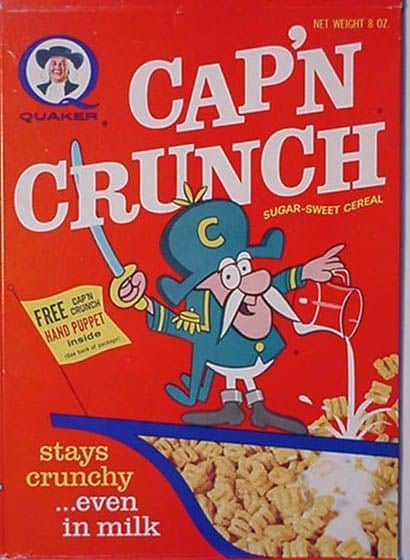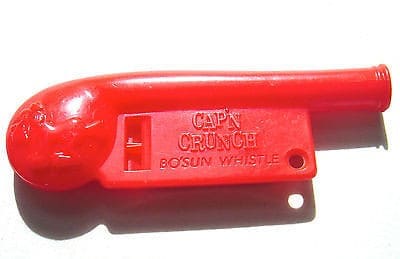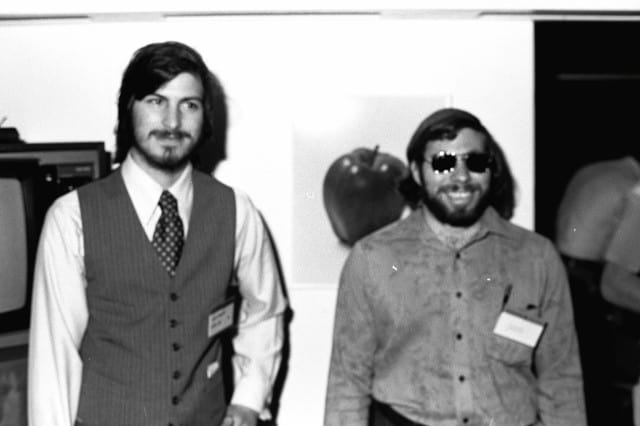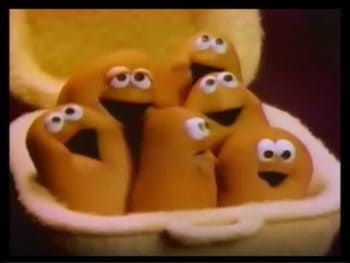
It’s amazing to think of how one random object can be responsible for changing the way our world works, and it all starts with a box of breakfast cereal.
For a kid growing up in the 70s and 80s, breakfast was an event. This was a whole new age of cereals that were geared towards kids, nutrition be damned it was all about bright colors, sugar, and cartoon characters that would help sell it.
Cereal commercials and cartoons seemed to be one and the same and as the deregulation of advertising to children became established in the 80s, there was no telling what was commercial and what was a cartoon.
Not only would the back of a cereal box serve as your morning newspaper, the prospect of any free toy inside made it feel like Christmas every time you got a new box. One significant cereal – and toy – would play a part in the creation of the worlds biggest tech company and, ultimately, to the phone, laptop, or tablet you may be reading this on right now.
The Captain Crunch toy whistle.
How Cap’n Crunch Gets The Story Going
So even though some of this takes place pre-80s, it’s significant because it sets up the evolution of Apple through the 80s and onward to today.
Cap’n Crunch is a cereal that goes back even further to 1963 and is a corn and oat-based cereal produced by Quaker Oats. The cereal has routes in an old recipe involving brown sugar and butter over rice. The creator of Cap’n Crunch, Pamela Low, was a “flavorist” and recalled this meal being made by her grandmother when she was younger and thought this could work well as a breakfast cereal.
This combination of flavors created a “want more-ishness” and would be the basis for the flavor coating of the cereal. They came up with the idea of a sea captain as their mascot and went with the name Cap’n Crunch.
If you want the real insight into the Cap’n, his full name is Horatio Magellan Crunch. He is captain of the “Guppy” and was born on “Crunch Island” in the “Sea Of Milk” – See, even cereal mascots have an origin story.
If you want more truth bombs Cap’n Crunch only has three stripes on his uniform which actually give him the title of “Commander” and not “Captain”. Your whole childhood is a lie but if you want to learn more about epic 80s cereals check out my article all about them!
The Cap’n Crunch Whistle

So there have been many great prizes found in cereal over the years and one non-descript item was put into Cap’n Crunch in the mid-60s – a simple little whistle.
It was called the Bo’sun whistle, and it was meant to replicate the whistle used by sailing captains to signal meal times and also commands. Just picture Captain Von Trapp in the Sound of Music…
So these were just cheap little red whistles and if you’ve read the great Ready Player One, you know what a significant part of that story it is.
The interesting thing with these whistles is the tone they give off which happens to be exactly 2600hz. And that leads to the next part of our story.
Who Were The Phreakers?
The Phreakers weren’t an 80s breakdance crew (though they should have been) but were an underground group of hackers – specifically phone hackers. This is still back in the 60s and 70s so computers, as we know them, weren’t really a thing. If you wanted to be a “hacker” you were either going to have to wait a decade or two or do what the underground Phreakers were doing: hacking phone lines.
Back then, the phone system worked on a series of tones all on different frequencies. The early hackers had found out what these tones were through the Bell System Technical Journal that could be found in any library (Bell would later scramble to have all these removed).
With the frequencies known you could now play them through your phone to bypass AT&T’s analog system and be able to make free long-distance phone calls. Whether you were actually looking to save money, or just wanted to circumvent a structured system, phone hacking had become a popular underground thing, and that leads us to Jon Draper.
Who Was Jon Draper?
No relation to the unfaithful marketing master Don Draper, Jon Draper could be considered one of the godfathers of early hacking. The Phreakers had existed for a while but it was Jon Draper who discovered that the 2600hz frequency of the Bo’sun whistle was able to bypass the phone analog system perfectly to make long-distance phone calls.
Draper would nickname himself “Captain Crunch” even though he wasn’t the first to discover the abilities of the Bo’sun whistle, he did take it to a larger scale. Draper created something he called the “Blue Box” which was an electronic box that could replicate those tones used by the phone company.
Again, this seemed more about mischief than money but Wind of this underground hacking movement grew in prominence that it became big enough to be featured in an Esquire article from 1971.
It was written by Ron Rosenbaum and was entitled: “Secrets of the Little Blue Box” and it told this whole story of the phreakers, the tones used by the phone companies, and the creation of the little blue box.
A mother in Berkley, California happened to see this article and thought it would interest her electronics obsessed son so she left it on the kitchen table for him.
Her son was Steve Wozniak
Before Apple Was Apple
I probably don’t need to rehash much of this because everyone on planet earth knows this but Steve Wozniak or “Woz” was friends with a young Steve Jobs and as soon as Woz was halfway through the article he was on the phone with Jobs reading the whole thing to him.
They were both psyched about this whole Phreakers movement and were pretty enamored with Jon Draper. As soon as they could they went and found that Bell Technical Journal and started buying parts to make an analog tone generator. They were able to replicate and “program” in the tones with a simple tape recorder.
Their analog version didn work perfectly and Woz started working on a digital version of the Blue Box that hadn’t been attempted before. Woz said he had never been prouder of something he designed and even though they called a wrong number on their first attempt, it worked.
Their first attraction to the Blue Box was more prank based and there’s even the story of Woz prank calling the Vatican pretending to be Henry Kissinger in an attempt to talk to the Pope.
He was sleeping apparently.
How Everything Was Taken To The Next Level
This is where the story of Apple really has its origin moment as an important milestone was about to be reached – Jobs came up with the idea that this hobby could be turned into something they could sell.
Jobs got all the components together to make a Blue Box and figured out how they would be able to price it. As is mentioned in the book “Steve Jobs” by Walter Isaacson, this was another moment foreshadowing what Apple would become.
They were able to get all the parts together for around $40 and decided to sell it for $150. They then started shopping it around by taking it to college dorms and give demonstrations of this new technology in action. They would make calls to London, Australia, and various other places all in front of their “audience” who took to them quickly. They sold out all 100 Blue Boxes they made.
What they realized with the Blue Box was that they had an ideal partnership. They both had the same passion for electronics and technology and with Woz as more of a behind-the-scenes man, Jobs was able to use his energy and personality to promote and grow.
Woz had the brilliance in creation and invention, Jobs had the foresight in how to make that idea user-friendly, and how to package, market, and sell it.
Woz had the skill, Jobs had the vision
What Happens Next?
On June 29, 1975, Wozniak came up with something that had never happened before: He created a motherboard that was connected to a monitor and when he typed a letter on a keyboard it showed up on the screen.
This is essentially the start of Apple as this was the basis for the Apple 1 which was basically like a kit where the buyer could add, and put together, more pieces to make it customizable. The main thing Jobs and Wozniak realized through this is they had a company on their hands. Their plan was to make about 50 circuit boards that would cost around $1000 and then sell them for $40 apiece.
In order to raise the money, Wozniak sold his $500 calculator and Jobs sold his Volkswagon bus for $1500 giving them capital, a design for a product, and a plan. And since Jobs was on a fruitarian diet, and had recently been pruning apple trees, they went with the name Apple computers.
It was thought the name Apple would take the edge off the name computer which was still seen as industrial, foreign, and mechanical. There was the thought that computers were going to take over and we were facing a George Orwell, “1984” Big Government situation. Another big feature with the name Apple is that it would get them ahead of another big tech-based company when listed in the phone book – Atari.
The Next Steps For The New Apple Company
This would lead them to the Apple II and a big innovation: telephone companies didn’t have a monopoly on phone lines anymore and other companies could create devices that could hook into them. Wozniak didn’t know much about phone lines, but he knew someone who did: Jon Draper.
Woz had tracked down and finally met Draper earlier on and Draper would work as an independent contractor for the newly formed “Apple” company. He ended up designing a telephone interface board that would lead the way for computers being able to tone-activated calling menus, voice mail, and other such technology.
Going into the 80s Draper would also help to develop the first word processor for the Apple II along with a 3D graphic design system and this would lead to the Apple III computer. This would lead to the iconic Macintosh in 1984 where Apple started to move to the forefront of the technology world – and where this happened…
The Evolution Of Apple
This could take weeks to cover, and most people know the progression of Apple but it’s in the 80s where – besides the Macintosh – they made their big strides with things like:
- The mouse
- Color display monitors
- Macintosh Plus
- Macintosh II
- Apple modems
They’ve released a ton of products but things would continue to evolve with the release of the Powerbook, the Newton, the iMac G3, and then in 2001, a device that would cause an earthquake in society: the iPod.
From there it would lead us to different versions of the Mac, the iPod Shuffle, the MacBook Pro, the iPod Shuffle, and then only July 11, 2008, the first iPhone.
From there you know the rest of the story as the iPhone has transformed the way that we exist, interact, and communicate. For better or for worse, the iPhone has changed our lives and brought us to the point where we have trouble imagining life without them.
Steve Jobs followed an obsessive path of design, functionality, and marketing to transform our lives making him a modern version of Thomas Edison – and possibly even bigger depending on your viewpoint.
Wrapping It Up

So if you’re reading this article on any form of Apple product, you can trace things back to all the products that came before it and all the way back to that first Blue Box. The Blue Box put into motion what Apple would become and the Blue Box can get traced back to a random encounter with a toy whistle that allowed people to undertake a bizarre new hobby.
If it wasn’t for Cap’n Crunch, and the Bo’sun whistle, we probably wouldn’t have Apple – and the technology – as it is today. The Blue Box is what gave Jobs and Wozniak the confidence of what was possible between the two of them.
Wozniak claimed: “If it hadn’t been for the Blue Boxes, there wouldn’t have been an Apple”. Jobs would back up this statement saying he was “100 sure” there wouldn’t have been an Apple without the Blue Box as it allowed them to see that it was possible to create something and put it into production.
And we wouldn’t have any of this life-changing technology if it wasn’t for a random little toy in a beloved breakfast cereal.



